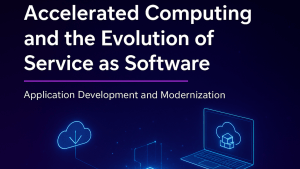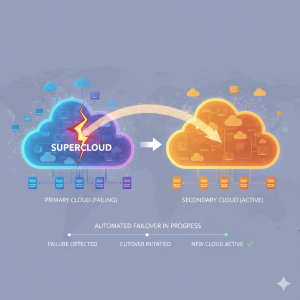The convergence of accelerated computing, application modernization, platform engineering, and DevSecOps is reshaping the software development landscape. This transformation isn’t just about new technology; it’s a shift that’s changing the way software is built, secured, and delivered across every industry.
Enabling Unprecedented Performance
Accelerated computing, which leverages specialized hardware such as GPUs, TPUs, and FPGAs, is allowing computations at a scale previously unattainable on traditional architectures. This evolution allows applications to process complex workloads, from real-time analytics to AI-driven decision-making. According to theCUBE Research AppDev practice, the cloud infrastructure GPU-based accelerated market is experiencing 46.8% growth in 2025, reaching $157.8 billion in value as AI infrastructure investments continue to expand.
For application developers, accelerated computing presents opportunities to build more responsive and intelligent applications. However, it also requires the adoption of new programming models and tools optimized for these high-performance architectures.
Transforming Legacy Systems
Application modernization has become essential for organizations seeking to remain competitive in the digital era. The application modernization services market was at $19.82 billion in 2024, is projected to reach $39.62 billion by 2029, reflecting the rapid adoption of cloud-native and microservices architectures. Key modernization strategies include rearchitecting legacy systems, migrating to cloud environments, and embedding continuous delivery pipelines.
Platform engineering teams are required to create robust, self-service platforms with Infrastructure as Code (IaC), container orchestration, and observability frameworks to ensure efficient and reliable application deployment.
Platform engineering should be considered as increasingly central to enabling developer productivity. In 2025, the focus has shifted from simply providing infrastructure to delivering comprehensive developer platforms that streamline workflows and enhance the developer experience (DevEx). Research by Google Cloud indicates that organizations with co-managed platforms allocate an average of 47% of developers’ productive time to innovation and experimentation, compared to 38% for organizations that rely solely on internal platform management.
Internal developer portals (IDPs) and self-service environments provide developers with tools to deploy, manage, and monitor applications more efficiently, reducing operational friction and accelerating innovation.
DevSecOps is Embedding Security Throughout the Lifecycle
As application complexity increases, robust security practices have become critical. The global DevSecOps market is projected to reach $41.66 billion by 2030, growing at a compound annual growth rate (CAGR) of 30.76% from 2022 to 2030. Key trends in DevSecOps include:
- Shift-Left Security – Integrating security testing early to prevent vulnerabilities from reaching production.
- AI-Driven Security Automation – Leveraging machine learning to detect and respond to threats in real time.
- Zero Trust Architectures – Continuously verifying all users and devices across network environments.
For application developers and platform engineers, implementing DevSecOps practices is essential to delivering secure, resilient, and compliant applications.
Service as a Software Emerging Business Model
The convergence of accelerated computing, application modernization, platform engineering, and DevSecOps has led to the emergence of a new business model: Service as a Software. In this model, software functions as the primary vehicle for delivering value, experiences, and services to customers.
Enterprises that adopt this model can leverage agentic, process-centric applications to accelerate innovation, optimize operations, and unlock new business opportunities. Organizations that delay adoption risk falling behind in an environment increasingly defined by speed, intelligence, and scalability.
Conclusion
Our research in AppDev concludes that the integration of accelerated computing, application modernization, platform engineering, and DevSecOps is fundamentally transforming the software development landscape. Application developers, platform engineers, and DevSecOps teams that embrace these converging trends are positioned to deliver the next generation of secure, scalable, and intelligent applications, driving business success in the digital era.
Our recommendations:
- Assess Current Application and Infrastructure Readiness
Organizations should perform a comprehensive audit of their existing applications, platforms, and DevSecOps processes to identify gaps in accelerated computing adoption, modernization potential, and security integration. This assessment should highlight which workloads can benefit most from GPUs, TPUs, or other accelerators, and which legacy systems require re-architecture to support cloud-native, scalable deployment. - Invest in Platform Engineering and Developer Enablement
Enterprises should prioritize building self-service platforms, internal developer portals (IDPs), and observability frameworks to empower application developers. By providing tools, automation, and standardized environments, organizations can accelerate innovation, reduce operational friction, and optimize developer productivity while ensuring that security and compliance standards are embedded into workflows. - Embed DevSecOps and Security Automation Across the Lifecycle
Integrating DevSecOps practices into every stage of software development is critical. Organizations should implement shift-left security, AI-driven threat detection, and zero-trust architectures to ensure applications are resilient and secure. Continuous monitoring, automated testing, and real-time security insights will help teams deploy intelligent, scalable applications with confidence.
The convergence of accelerated computing, application modernization, platform engineering, and DevSecOps is altering the landscape of software development. Organizations that proactively embrace these trends position themselves to build applications that are not only more secure and scalable but also intelligent and responsive to evolving business needs. By assessing current capabilities, investing in developer enablement, and embedding security throughout the development lifecycle, enterprises can drive innovation, optimize operations, and unlock new opportunities for value creation in the digital era.



